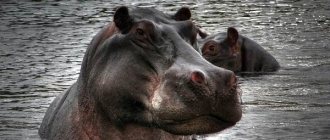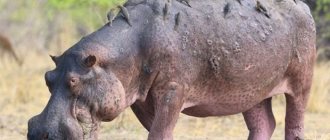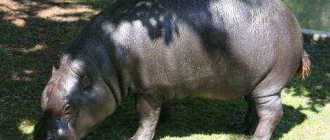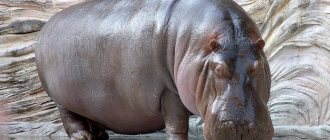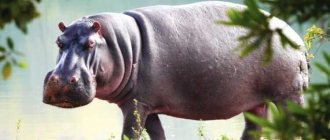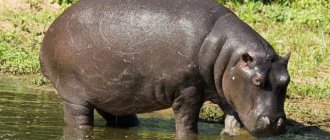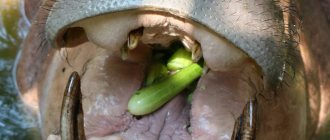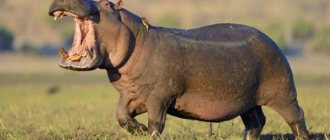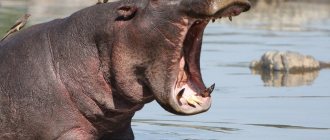- Wild animals
- >>
- Mammals
The hippopotamus is one of the largest animals on earth.
It is second only to African elephants. Rhinoceroses can also compete with them in size and weight. Despite their impressive size and heavy weight, hippos can be very fast and agile animals. For a long time, pigs were considered the ancestors and relatives of rhinoceroses. However, not so long ago, zoological researchers put forward a stunning theory of their relationship with whales!
Description of the hippopotamus
Adults are large, growing up to 3.2 tons. With a body length of up to 500 cm along with a tail of 35 cm. The height of adult individuals at the withers is approximately one and a half meters. Hippopotamus skin color ranges from gray-violet to gray-green. There are small pinkish-brown areas around the eyes and ears. The body of mammals, like that of whales, is almost completely hairless. There is no hair on the head and tail, but there are sparse small thin hairs throughout the body.
Appearance of a hippopotamus
Appearance of a hippopotamus
Appearance of a hippopotamus
Appearance of a hippopotamus
Appearance of a hippopotamus
The outer skin of a hippopotamus is not very thick, so they are vulnerable during contractions. Animals completely lack sebaceous and sweat glands. An oily red liquid is released from the mucous membranes, which was previously mistaken for sweat mixed with blood. Now scientists have found that it is a mixture of hipposudoric and norhipposudoric acids. Red sweat protects the hippopotamus's body from harmful ultraviolet light and prevents the development and proliferation of pathogenic bacteria on the body. Initially, the discharge has no color, but after a few minutes of exposure to the sun, the discharge changes to orange and red.
Red Sweat Hippo
Despite their external clumsiness, hippos are quite maneuverable creatures. They have adapted to environmental conditions in such a way that they can move calmly both on the surface and in water. On land, seemingly clumsy animals can run at a speed of 30 km per hour, covering several hundred meters. In shallow waters, short and powerful legs move quickly along the bottom thanks to the webbed structure of their paws.
hippopotamus paw
The eyes, ears and nostrils of the animal are specially located so that the animal can exist under water most of the time, controlling the situation and without suffocating. When the hippopotamus is completely immersed in a body of water, it closes its nostrils and ears. Water can no longer get in there.
Hippopotamus in the water
The powerful jaws of hippopotamuses open at an angle of up to 150 degrees. In the animal's mouth there are large and sharp fangs and incisors. The canines can grow up to 50 cm, and the remaining teeth - up to 40. The canines are constantly sharpened against each other while eating.
hippopotamus jaw
The differences between males and females are practically invisible in appearance in young individuals. Individuals of the stronger sex only weigh 200 kg more than females, which does not stand out as much due to their weight of several tons. However, males grow continuously, while females stop growing at 25 years of age. Over the course of their entire lives, male hippos grow up to five meters in size, and females up to 3.5. The largest male in history weighed 4.5 tons. The jaws of males are larger and more developed, and the teeth are also larger.
Interesting fact : hippos can dive by holding their breath for up to 10 minutes.
Dimensions
The hippopotamus is one of the most massive land mammals. The average weight of animals reaches 1.6-2 tons, although among individuals of the common hippopotamus there are often giant males weighing 3-3.5 tons or more. Females are usually somewhat smaller: their weight is on average 20% less. The height of an adult hippopotamus at the withers is 1.5-1.65 m, and the body length is from 3 to 5 m.
The dimensions of pygmy hippopotamuses are as follows: weight - about 200 kg, height at the withers - 80 cm, body length - up to 170-180 cm. Newborn cubs of the common hippopotamus weigh about 40 kg, height 50 cm with a body length of up to 1 m.
The impressive weight of an adult hippopotamus is the main reason for certain changes in the structure of the skeleton: the bones have become more massive, the vertebrae have increased in size, and the shoulder blades have become vertical.
What is the difference between a hippopotamus and a hippopotamus?
The Latin name for hippopotamuses was borrowed from ancient Greek, from which Hippopotamus means “river horse.” Hippos got their name because they lived in rivers and made sounds similar to the neighing of horses. In the CIS countries and Russia, the name “Behemoth” was adopted, taken from the book of Job and denoting the demon of carnal desires. Thus, the same animal is called by two names. Hippopotamus and hippopotamus are one and the same .
Interesting: Chameleon
